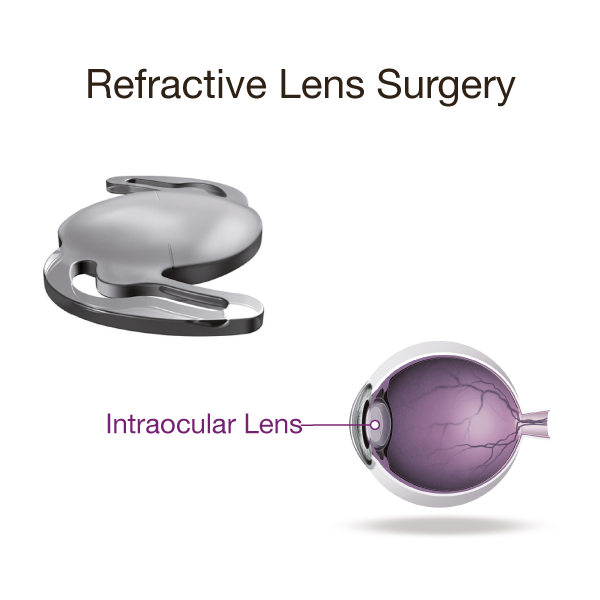
Improving your everyday quality of life
Treatments we provide

Laser Vision Correction
One of the most well defined and safest medical procedures in the world.
With over 30 million procedures undertaken worldwide, the safety profile of laser refractive surgery is well-established. The aim of laser eye surgery is to reshape the cornea (the window to the eye) to reduce the dependence upon glasses or contact lenses.
Two main forms of laser surgery exist. Surgery that involves a flap created on the surface of the eye in the form of LASIK, and treatments that do not have a flap that affect the surface of the eye directly (LASEK).Other procedures can be used where lenticules can be removed from the eye. These procedures are undertaken within the Private Patient Centre at Manchester Royal Eye Hospital, using the latest femtosecond and Excimer laser technology.

A thin flap is created using bladeless, femto second laser technology on the surface of the eye. This provides a highly accurate and safe approach to creating a flap, and also gives the option to further customise detailed treatment for patients. The flap acts as a natural bandage, aiding rapid visual recovery and reducing pain after the procedure.
During the procedure, the flap is gently lifted to allow the Excimer laser treatment to be applied underneath the flap. It is then carefully repositioned meaning healing can start immediately. No stitches are required to hold the flap in position, only the natural healing of the eye.
LASIK Surgery (Flap based)

LASEK surgery utilises excimer laser technology to apply laser directly to the surface of the eye, and no flap is created. This is usually undertaken in specific situations where your eye is not deemed suitable for flap based surgery. This type of surgery is safe and effective, with visual outcomes being comparable to flap based (LASIK) surgery.
As the laser is applied directly to the surface of the eye, it can create more short term post-operative discomfort than LASIK surgery, and the healing process can be slower, meaning the visual recovery takes a bit longer than flap based surgery.
LASEK Surgery (Flapless)
Crosslinking
When used effectively, this procedure can stabilise the corneal shape in conditions such as keratoconus and reduce the need to undertake corneal transplants.
This is a very safe procedure that can be performed on an outpatient basis, not requiring a hospital stay or a general anaesthetic in most cases. Most patients only require eye numbing drops to undertake the procedure. We will discuss these options with you in detail and help you decide on the best course of action for you.

PTK also known as photo-therapeutic keratectomy is a laser surgical procedure to manage various corneal conditions. PTK treats superficial corneal disease, irregularities, and opacities. It is an effective alternative for LASIK patients who have been diagnosed with epithelial basement membrane dystrophy.
PTK Surgery

Refractive lens surgery is suitable for patients aged 50 or over, though younger patients can be considered in some cases, and with a glasses prescription higher than the normal range for laser eye surgery.
Lens clarity and flexibility diminish with age, and many older patients who would like their sight corrected actually have the beginnings of a cataract. Replacing the natural lens is often therefore the best option for sight correction, even for patients with a lower prescription, particularly if they are long-sighted.
Other candidates for refractive lens surgery include those with astigmatism, and glaucoma (as long as the condition is stable)
Your surgeon will scan and test your eyes during your initial consultation to assess your suitability.
This includes the use of toric intraocular lenses to significantly improve vision in patients that have astigmatism, which is often referred to as an uneven cornea, that is more rugby ball-shaped, as opposed to football-shaped.
We also offer a range of premium lens treatments, including multifocal and extended depth of focus lenses, providing a range of good vision over all distances.
These are tailored towards an individual’s needs and can be discussed in detail at your appointment.
Not all people are suitable for every kind of lens and thorough consultation and testing is required to determine your suitability.
Refractive Lens Surgery

Implantable Contact / Collamer Lens
Implantable lenses are often used for patients that are not suitable for laser refractive surgery, providing an excellent option to reduce dependence on glasses.
The EVO Visian ICL (Implantable Collamer® Lens) manufactured by STAAR Surgical and the IPCL are lenses that are implanted through a keyhole incision in the eye behind the iris and in front of the natural lens. The lens contains collagen which naturally occurs in your body. It is called a phakic implant because your eye still has its natural lens retained.

These rings can be inserted into the cornea and are usually used to treat conditions such as keratoconus, and corneal transplants.
Intrastromal rings aim to flatten the cornea in certain areas. This then allows other options to be used in conjunction, such as spectacles or contact lenses. Modern laser technology is used to create tracks within the cornea where the implants sit. This can be undertaken under local anesthetic as a day procedure.
Intrastromal Rings
